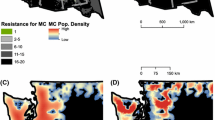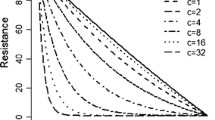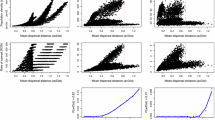Abstract
Applied ecology could benefit from new tools that identify potential movement pathways of invasive species, particularly where data are sparse. Cost surface analysis (CSA) estimates the permeability (friction) across a landscape and can be applied to dispersal modelling. Increasingly used in a diversity of applications, several fundamental assumptions that might influence the outputs of CSA (cost surfaces and least-cost pathways) have yet to be systematically examined. Thus, we explore two issues: the presumed relationship between habitat preferences and dispersal behaviour as well as the degree of landscape fragmentation through which an organism moves by modelling a total of 18 sensitivity and dispersal scenarios. We explored the effect of fragmentation by altering the friction values (generally assigned using expert opinion) associated with patch and linear features. We compared these sensitivity scenarios in two sites that differed in fragmentation. We also used eastern grey squirrels (Sciurus carolinensis) as an example invading species and compared diffusion models and two contrasting cost surface dispersal scenarios. The diffusion model underestimated spread because squirrels did not move randomly through the landscape. Despite contrasting assumptions regarding dispersal behaviour, the two cost surfaces were strikingly similar while the least-cost paths differed. Furthermore, while the cost surfaces were insensitive to changes in friction values for linear features, they were sensitive to assumptions made for patch features. Our results suggest that movement in fragmented landscapes may be more sensitive to assumptions regarding friction values than contiguous landscapes. Thus, the reliability of CSA may depend not only on the range of friction values used for patches but also the degree of contiguity in the landscape.





Similar content being viewed by others
References
Adriaensen F, Chardon JP, De Blust G, Swinnen E, Villalba S, Gulinck H, Matthysen E (2003) The application of ‘least-cost’ modelling as a functional landscape model. Landsc Urban Plan 64:233–247
Allen LJS, Allen EJ, Kunst CRG, Sosebee RE (1991) A diffusion model for spread of Opuntia imbricata (cholla) on rangeland. J Ecol 79:1123–1135
Andow DA, Kareiva PM, Levin SA, Okubo A (1990) Spread of invading organisms. Landsc Ecol 4:177–188
Bunn AG, Urban DL, Keitt TH (2000) Landscape connectivity: a conservation application of graph theory. J Environ Manage 59:265–278
Collischonn W, Pilar JV (2000) A direction dependent least-cost-path algorithm for roads and canals. Int J Geogr Inf Sci 14:397–406
Doak DF, Mills LS (1994) A useful role for theory in conservation. Ecology 75:615–626
Douglas DH (1994) Least-cost path in GIS using an accumulated weighted surface and slope lines. Cartographica 31:37–51
Dunning JB, Stewart DJ, Danielson BJ, Noon BR, Root TL, Lamberson RH, Stevens EE (1995) Spatially explicit population-models—current forms and future uses. Ecol Appl 5(1):3–11
Feldman SC, Pelletier RE, Walser E, Smoot JC, Ahl D (1995) A prototype for pipeline routing using remotely sensed data and geographic information system analysis. Remote Sens Environ 53:123–131
Ferreras P (2001) Landscape structure and asymmetrical inter-patch connectivity in a metapopulation of the endangered Iberian lynx. Biol Conserv 100:125–136
Foody, GM (2006) What is the difference between two maps? A remote senser's view. J Geogr Syst 8(2):119–130
Foody GM (2002) Status of land cover classification accuracy assessment. Remote Sens Environ 80:185–201
Gergel SE (2007) New directions in landscape pattern analysis and linkages with remote sensing. In: Wulder MA, Franklin SE (eds) Remote sensing spatial pattern. Taylor & Francis—CRC Press
Gonzales EK (2005) The distribution and habitat selection of introduced eastern grey squirrels (Sciurus carolinensis) in British Columbia. Can Field Nat 119:343–350
Gonzales EK (1999) The grey squirrel in British Columbia: an introduction to an introduction. Discovery 28:22–25
Guiguet CJ (1975) An introduction of the grey squirrel on Vancouver Island. Syesis 8:399
Gurnell J (1987) The natural history of squirrels. Christopher Helm, London, UK
Gurnell J, Wauters LA, Lurz PWW, Tosi G (2004) Alien species and interspecific competition: effects of introduced eastern grey squirrels on red squirrel population dynamics. J Anim Ecol 73:26–35
Hagen A (2003) Fuzzy set approach to assessing similarity of categorical maps. Int J Geogr Inf Sci 17(3):235–249
Hagen-Zanker A (2006) Comparing continuous valued raster data: a cross disciplinary literature scan. Research Institute for Knowledge Systems. Maastricht, The Netherlands
Hastings A, Cuddington K, Davies KF, Dugaw CJ, Elmendorf S, Freestone A, Harrison S, Holland M, Lambrinos J, Malvadkar U, Melbourne BA, Moore K, Taylor C, Thomson D (2005) The spatial spread of invasions: new developments in theory and evidence. Ecol Lett 8(1):91–101
Hengeveld R (1994) Small step invasion research. Trends Ecol Evol 9:339–342
Hwang Y (2005) A test of interspecific effects of Eastern Grey Squirrels on Douglas's squirrels in Vancouver, British Columbia. Canadian Field Naturalist 119 (in press)
Jaeger JAG, Bowman J, Brennan J, Fahrig L, Bert D, Bouchard J, Charbonneau N, Frank K, Gruber B, von Toschanowitz KT (2005) Predicting when animal populations are at risk from roads: an interactive model of road avoidance behaviour. Ecological Modell 185:329–348
Kenward RE, Parish T (1986) Bark-stripping by gray squirrels (Sciurus carolinensis). J Zool 210:473–481
Kramer-Schadt S, Revilla E, Wiegand T, Breitenmoser U (2004) Fragmented landscapes, road mortality and patch connectivity: modelling influences on the dispersal of Eurasian lynx. J Appl Ecol 41:711–723
Lurz PWW, Rushton SP, Wauters LA, Bertolino S, Currado I, Mazzoglio P, Shirley MDF (2001) Predicting grey squirrel expansion in north Italy: a spatially explicit modelling approach. Landsc Ecol 16:407–420
Lurz PWW, Geddes N, Lloyd AJ, Shirley MDE, Rushton SP, Burlton B (2003) Planning a red squirrel conservation area: using a spatially explicit population dynamics model to predict the impact of felling and forest design plans. Forestry 76:95–108
Mack RN, Simberloff D, Lonsdale WM, Evans H, Clout M, Bazzaz, FA (2000) Biotic invasions: causes, epidemiology, global consequences, and control. Ecol Appl 10:689–710
Manly BFJ, McDonald LL, Thomas DL, McDonald TL, Erikson WP (2002) Resource selection by animals: statistical design and analysis for field studies, 2nd edn. Kluwer Academic Publishers, Dordrecht, the Netherlands
Middleton AD (1930) The ecology of the American gray squirrel (Sciurus carolinensis Gmelin) in the British Isles. Proc Zool Soc Lond 2:809–843
Mountford EP (1997) A decade of grey squirrel bark stripping damage to beech in Lady Park wood, UK. Forestry 70:17–29
Myers JA, Vellend M, Gardescu S, Marks PL (2004) Seed spread by white-tailed deer: implications for long-distance spread, invasion, and migration of plants in eastern North America. Oecologia 139:35–44
Nathan R, Perry G, Cronin JT, Strand AE, Cain ML (2003) Methods for estimating long-distance dispersal. Oikos 103:261–273
Nikolakaki P (2004) A GIS site-selection process for habitat creation: estimating connectivity of habitat patches. Landsc Urban Plan 68:77–94
Ó Teangana D, Reilly R, Montgomery WI, Rochford J (2000) Distribution and status of the red squirrel (Sciurus vulgaris) and grey squirrel (Sciurus carolinensis) in Ireland. Mammal Rev 30:45–56
Okubo A, Maini PK, Williamson MH, Murray JD (1989) On the spatial spread of the grey squirrel in Britain. Proc R Soc Lond 238:113–125
Palomares F (2001) Vegetation structure and prey abundance requirements of the Iberian lynx: implications for the design of reserves and corridors. J Appl Ecol 38(1):9–18
Pimentel D, Lach L, Zuniga R, Morrison D (2000) Environmental and economic costs of nonindigenous species in the United States. BioScience 50:53–64
Power C, Simms A, White R (2001) Hierarchical fuzzy pattern matching for the regional comparison of land use maps. Int J Geogr Inf Sci 15(1):77–100
Pysek P, Hulme PE (2005) Spatio-temporal dynamics of plant invasions: linking pattern to process. Ecoscience 12:302–315
Ray N, Lehmann A, Joly P (2002) Modelling spatial distribution of amphibian populations: a GIS approach based on habitat matrix permeability. Biodivers Conserv 11:2143–2165
Rejmánek M, Pitcairn MJ (2002) When is eradication of exotic pest plants a realistic goal? In: Veitch D, Clout M (eds) Turning the tide: eradication of invasive species. Invasive Species Specialist Group of the World Conservation Union (IUCN). Gland, Switzerland and Cambridge, UK, pp 249–253
Revilla E, Wiegand T, Palomares F, Ferreras P, Delibes M (2004) Effects of matrix heterogeneity on animal dispersal: from individual behavior to metapopulation-level parameters. Am Nat 164(5):E130–E153
Reynolds JC (1985) Details of the geographic replacement of the red squirrel (Sciurus vulgaris) by the grey squirrel (Sciurus carolinensis) in eastern England. J Anim Ecol 54:149–162
Robinson DJ, McTaggart-Cowan I (1954) An invasive population of the Gray Squirrel (Sciurus carolinensis Gmelin) in British Columbia. Can J Zool 32:261–282
Ruckelshaus M, Hartway C, Kareiva P (1997) Assessing the data requirements of spatially explicit dispersal models. Conserv Biol 11(6):1298-1306
Sharov AA (2004) Bioeconomics of managing the spread of exotic pest species with barrier zones. Risk Anal 24:879–892
Sheail J (1999) The grey squirrel (Sciurus carolinensis)—a UK historical perspective on a vertebrate pest species. J Environ Manage 55:145–156
Shigesada N, Kawasaki K, Takeda Y (1995) Modelling stratified diffusion in biological invasions. Am Nat 146:229–251
Shorten M (1957) Squirrels in England, Wales and Scotland, 1955. J Anim Ecol 26:287–294
Simberloff D (2003) How much information on population biology is needed to manage introduced species? Conserv Biol 17:83–92
Skellam JG (1951) Random spread in theoretical populations. Biometrika 38:286–308
Suarez AV, Holway DA, Case TJ (2001) Patterns of spread in biological invasions dominated by long-distance jump spread: insights from argentine ants. Proc Nat Acad Sci USA 98:1095–1100
Verbeylen G, De Bruyn L, Adriaensen F, Matthysen E (2003) Does matrix resistance influence red squirrel (Sciurus vulgaris L. 1758) distribution in an urban landscape? Landsc Ecol 76:95–108
Visser H, de Nijs T (2006) The Map Comparison Kit. Environ Modell Softw 21(3): 346–358
Wauters L, Gurnell J, Currado I, Mazzoglio PJ (1997) Grey squirrel Sciurus carolinensis management in Italy—squirrel distribution in a highly fragmented landscape. Wildl Biol 3:117–124
Zollner PA, Lima SL (2005) Behavioral tradeoffs when dispersing across a patchy landscape. Oikos 108(2):219–230
Acknowledgements
Financial support for EKG was provided by a National Science and Engineering Research Council (NSERC) Industrial Postgraduate Scholarship, Pacific Region Environmental Systems Research Institute of Canada, Arthur Richmond Memorial Scholarship Graduate Scholarship at the University of Guelph, and the Mountain Equipment Co-Op Environment Fund. Digital data was generously provided by Geographic Data British Columbia, British Columbia Ministry of Environment, Land and Parks, Greater Vancouver Regional District, and Crown Lands Registry Services. EKG greatly appreciates the intellectual support from Dr. Tom Nudds and Dr. Peter Arcese. Thank you to the survey respondents, many of whom submitted interesting stories. We are grateful to Jessie Hui-Chung Wu, Janelle Curtis, Thorsten Wiegand, Patrick Lilley, and the anonymous reviewers who made improvements to earlier versions of the manuscript.
Author information
Authors and Affiliations
Corresponding author
Appendix
Appendix
Digital data sources, scale, feature type and year last modified
Map | Source | Site | Scale | Feature type | Year |
|---|---|---|---|---|---|
Greater Vancouver Generalized Land Use Map | The Policy and Planning Department, Regional Development Division of the Greater Vancouver Regional District | Fragmented | 1:210000 | Polygon | 2001 |
Basemap Thematic Mapping Landuse | Geographic Data British Columbia and the BC Ministry of Environment, Land and Parks | Contiguous | 1:250000 | Polygon | 1999 |
Municipal Cadastral Data | Crown Lands Registry Services | Contiguous | 1:10000 | Polygon | 1999 |
Terrain Resource Information Management (TRIM) I | Geographic Data British Columbia and the BC Ministry of Environment, Land and Parks | Contiguous & Fragmented | 1:10000 | Line | 2001 |
Rights and permissions
About this article
Cite this article
Gonzales, E.K., Gergel, S.E. Testing assumptions of cost surface analysis—a tool for invasive species management. Landscape Ecol 22, 1155–1168 (2007). https://doi.org/10.1007/s10980-007-9106-6
Received:
Accepted:
Published:
Issue Date:
DOI: https://doi.org/10.1007/s10980-007-9106-6




